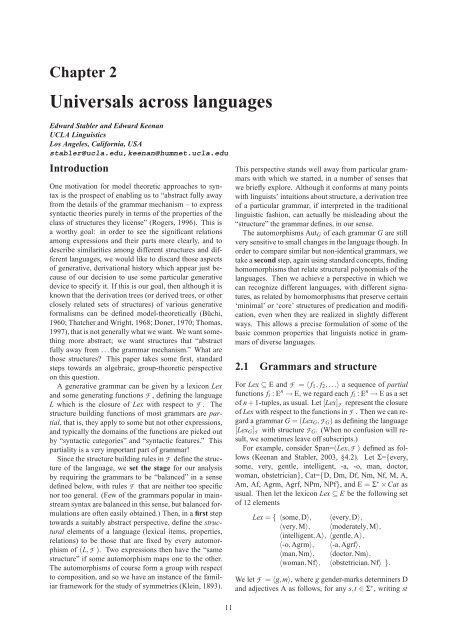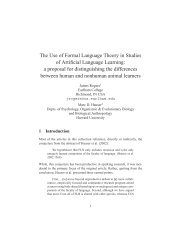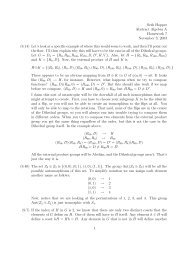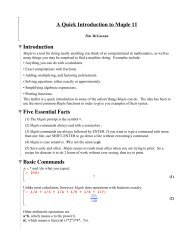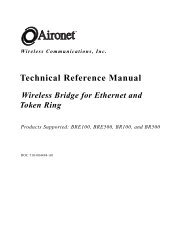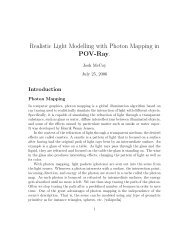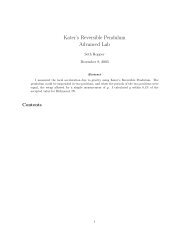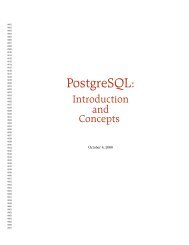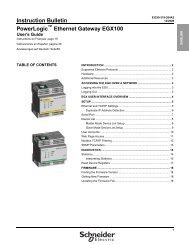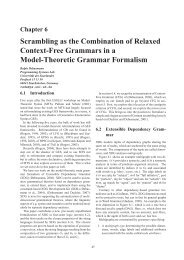Model-Theoretic Syntax at 10 - Earlham Computer Science ...
Model-Theoretic Syntax at 10 - Earlham Computer Science ...
Model-Theoretic Syntax at 10 - Earlham Computer Science ...
Create successful ePaper yourself
Turn your PDF publications into a flip-book with our unique Google optimized e-Paper software.
Chapter 2<br />
Universals across languages<br />
Edward Stabler and Edward Keenan<br />
UCLA Linguistics<br />
Los Angeles, California, USA<br />
stabler@ucla.edu,keenan@humnet.ucla.edu<br />
Introduction<br />
One motiv<strong>at</strong>ion for model theoretic approaches to syntax<br />
is the prospect of enabling us to “abstract fully away<br />
from the details of the grammar mechanism – to express<br />
syntactic theories purely in terms of the properties of the<br />
class of structures they license” (Rogers, 1996). This is<br />
a worthy goal: in order to see the significant rel<strong>at</strong>ions<br />
among expressions and their parts more clearly, and to<br />
describe similarities among different structures and different<br />
languages, we would like to discard those aspects<br />
of gener<strong>at</strong>ive, deriv<strong>at</strong>ional history which appear just because<br />
of our decision to use some particular gener<strong>at</strong>ive<br />
device to specify it. If this is our goal, then although it is<br />
known th<strong>at</strong> the deriv<strong>at</strong>ion trees (or derived trees, or other<br />
closely rel<strong>at</strong>ed sets of structures) of various gener<strong>at</strong>ive<br />
formalisms can be defined model-theoretically (Büchi,<br />
1960; Th<strong>at</strong>cher and Wright, 1968; Doner, 1970; Thomas,<br />
1997), th<strong>at</strong> is not generally wh<strong>at</strong> we want. We want something<br />
more abstract; we want structures th<strong>at</strong> “abstract<br />
fully away from . . . the grammar mechanism.” Wh<strong>at</strong> are<br />
those structures This paper takes some first, standard<br />
steps towards an algebraic, group-theoretic perspective<br />
on this question.<br />
A gener<strong>at</strong>ive grammar can be given by a lexicon Lex<br />
and some gener<strong>at</strong>ing functionsF , defining the language<br />
L which is the closure of Lex with respect toF . The<br />
structure building functions of most grammars are partial,<br />
th<strong>at</strong> is, they apply to some but not other expressions,<br />
and typically the domains of the functions are picked out<br />
by “syntactic c<strong>at</strong>egories” and “syntactic fe<strong>at</strong>ures.” This<br />
partiality is a very important part of grammar!<br />
Since the structure building rules inF define the structure<br />
of the language, we set the stage for our analysis<br />
by requiring the grammars to be “balanced” in a sense<br />
defined below, with rulesF th<strong>at</strong> are neither too specific<br />
nor too general. (Few of the grammars popular in mainstream<br />
syntax are balanced in this sense, but balanced formul<strong>at</strong>ions<br />
are often easily obtained.) Then, in a first step<br />
towards a suitably abstract perspective, define the structural<br />
elements of a language (lexical items, properties,<br />
rel<strong>at</strong>ions) to be those th<strong>at</strong> are fixed by every automorphism<br />
of (L,F ). Two expressions then have the “same<br />
structure” if some automorphism maps one to the other.<br />
The automorphisms of course form a group with respect<br />
to composition, and so we have an instance of the familiar<br />
framework for the study of symmetries (Klein, 1893).<br />
This perspective stands well away from particular grammars<br />
with which we started, in a number of senses th<strong>at</strong><br />
we briefly explore. Although it conforms <strong>at</strong> many points<br />
with linguists’ intuitions about structure, a deriv<strong>at</strong>ion tree<br />
of a particular grammar, if interpreted in the traditional<br />
linguistic fashion, can actually be misleading about the<br />
“structure” the grammar defines, in our sense.<br />
The automorphisms Aut G of each grammar G are still<br />
very sensitive to small changes in the language though. In<br />
order to compare similar but non-identical grammars, we<br />
take a second step, again using standard concepts, finding<br />
homomorphisms th<strong>at</strong> rel<strong>at</strong>e structural polynomials of the<br />
languages. Then we achieve a perspective in which we<br />
can recognize different languages, with different sign<strong>at</strong>ures,<br />
as rel<strong>at</strong>ed by homomorphisms th<strong>at</strong> preserve certain<br />
‘minimal’ or ‘core’ structures of predic<strong>at</strong>ion and modific<strong>at</strong>ion,<br />
even when they are realized in slightly different<br />
ways. This allows a precise formul<strong>at</strong>ion of some of the<br />
basic common properties th<strong>at</strong> linguists notice in grammars<br />
of diverse languages.<br />
2.1 Grammars and structure<br />
For Lex ⊆ E andF = 〈 f 1 , f 2 ,...〉 a sequence of partial<br />
functions f i : E n → E, we regard each f i : E n → E as a set<br />
of n+1-tuples, as usual. Let [Lex] F represent the closure<br />
of Lex with respect to the functions inF . Then we can regard<br />
a grammar G = (Lex G ,F G ) as defining the language<br />
[Lex G ] F with structureF G . (When no confusion will result,<br />
we sometimes leave off subscripts.)<br />
For example, consider Span=(Lex,F ) defined as follows<br />
(Keenan and Stabler, 2003, §4.2). Let Σ={every,<br />
some, very, gentle, intelligent, -a, -o, man, doctor,<br />
woman, obstetrician}, C<strong>at</strong>={D, Dm, Df, Nm, Nf, M, A,<br />
Am, Af, Agrm, Agrf, NPm, NPf}, and E = Σ ∗ × C<strong>at</strong> as<br />
usual. Then let the lexicon Lex ⊆ E be the following set<br />
of 12 elements<br />
Lex = { 〈some,D〉, 〈every,D〉,<br />
〈very,M〉, 〈moder<strong>at</strong>ely,M〉,<br />
〈intelligent,A〉, 〈gentle,A〉,<br />
〈-o,Agrm〉, 〈-a,Agrf〉,<br />
〈man,Nm〉, 〈doctor,Nm〉,<br />
〈woman,Nf〉, 〈obstetrician,Nf〉 }.<br />
We letF = 〈g,m〉, where g gender-marks determiners D<br />
and adjectives A as follows, for any s,t ∈ Σ ∗ , writing st<br />
11


